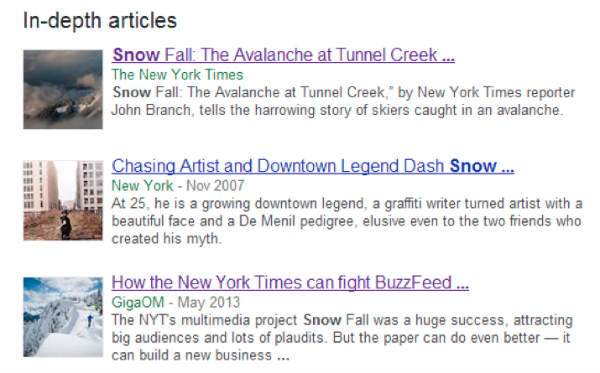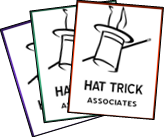jhaynes
This user hasn't shared any profile information
Posts by jhaynes

Should You Optimize Content for Google’s In-Depth Article Results?
Content Marketing Trends – Google’s New In-Depth Article Results
Last year Google texted 150 randomly as part of an experiment, asking them “What did you want to know recently?” This was designed to uncover what thinks people needed to know but didn’t consider using Google to find. And the research was almost surely a driver in Google’s newest algorithm change, called Hummingbird.
Both the in-depth article results and Hummingbird seem to follow a similar pattern: Google doesn’t just want to provide you with what you’re looking for, but also results that address WHY you’re looking for it. In other words, Google doesn’t want to just provide search results, they want to provide answers.
Google’s research has found that up to 10% of their users’ daily information needs involve learning about a broad topic, and this has led them to provide new search results that help users find in-depth articles.
What does this mean for content marketers?
If you want to create a content plan for appearing in in-depth article results, you could consider taking Google up on a few of its suggestions, like:
Use schema article markup
Use Google Authorship markup
Use proper coding for paginated articles
Use schemas to highlight your organization’s logo
Create compelling in-depth content
This makes it sound like content marketers have an opportunity to follow these guidelines and get their content to appear in the in-depth search results. But it may not be as easy as it sounds.
Research on the above factors and how they actually impact the results has recently been done, to determine if content marketers can or should try to optimize their content plan in order to appear as in-depth articles.
On The Official Google Search blog, Pandu Nayak mentions how publisher status factors into the in-depth search results: “In addition to well-known publishers, you’ll also find some great articles from lesser-known publications and blogs.”
But recent research done by the Content Marketing Institute showed that although publisher status and page rank were extremely critical for in-depth article rankings. In fact, in all of the test searches done by the institute, having a page rank of 7 or higher was essentially mandatory (only one search result had a lower ranking, a 6).
Their findings on each of the other criteria as they related to the search results they found were also contradictory to their previous stated list.
Google suggested that publishers “provide Authorship markup” in order to increase the odds of appearing in in-depth search results, however not one of the results found had the proper authorship citations.
Google also has said they are happy to see people continue to invest in thoughtful in-depth content that remains relevant for months or ever years after publication. This would seem to indicate that the in-depth article results may include articles with older post dates. However, once again the search results tell a different story. The CMI research showed that articles from 2012 made their in-depth list 6 out of 18 times, while only two articles were 2008 or earlier (the earliest was from 2003).
The research also showed that the number of social shares at this time seems to have little impact, with the number of Google+’s seems to have an even smaller impact.
Google’s webmaster tools help page states, “For this feature, it’s particularly helpful if you can implement certain aspects of the Schema.org article markup.” It goes on to list the most important schema markup (aka HTML tag) attributes of content:
headline
alternativeHeadline (a secondary headline, or subheading)
image (i.e., the URL of the image, as it must be crawlable and indexable)
description (a short description of the content)
datePublished
articleBody
Out of random searches that produced in-depth article results, 22 of the 59 articles included no schema markup, and another 22 out of 59 had “some” schema markup.
Google’s in-depth article search results have only been around for two months. Currently, it doesn’t seem that Google’s initial guidelines have much impact on what actually shows in search results, but this could change at any time of course.
For content marketers, it probably isn’t wise to put much effort into trying to appear in in-depth article search at the moment. Rather, it seems we should just continue doing what Google and readers want us to do most, which is to provide answers and solutions through quality content.

Top Content Marketing Strategy: Helpful Information as the Sales Pitch
 Content marketing is all the buzz, and it has changed the way we do business. An effective content marketing strategy now serves an increasingly significant role in marketing departments throughout the world. Whether you’re working to generate leads, improve search engine rankings, or boost sales efforts, content is a big deal.
Content marketing is all the buzz, and it has changed the way we do business. An effective content marketing strategy now serves an increasingly significant role in marketing departments throughout the world. Whether you’re working to generate leads, improve search engine rankings, or boost sales efforts, content is a big deal.
Some companies, however, are missing the point. Avoid wasting your time and follow the top content marketing strategy out there – make helpful information your new sales pitch. From e-commerce to SaaS, business is no longer about the sale, it’s about customer service and education.
Why Build an Educational Content Marketing Strategy
Let’s say you’re selling light bulbs. Your prospective online customers are probably homeowners or business owners, and they’re either replacing a burned out bulb or outfitting a new building with brand new lighting fixtures. Either way, you’re trying to convince these web surfers that your light bulb web store deserves their time over any other light bulb web store. How are you going to do that?
Answer: By helping them.
When a prospective customer first discovers a new need, such as light bulbs, the final purchase is rarely the first step in solving that need. Rather, it’s usually next to last. That means the final sale cannot be the focus of your content marketing strategy. The new sales pitch is helpful information.
Google has coined the marketing term “zero moment of truth” or ZMOT to explain where in the purchasing process educational content comes into play. The ZMOT is the first step in the process – conducting initial research.
These days, most everyone goes online to find out more about a desired service or product. During this time, they’re not yet in buying mode. They’re in learning mode. Of course, the ZMOT phase in the purchasing process isn’t new, but with the growth of online stores, review websites, and social media, this phase has become incredibly more important to consumers.
According to Google (easily one of the most influential companies in the marketing industry), “Before making an online purchase decision, a customer may engage with your brand through many different media channels over several days” (The Customer Journey to Online Purchase). In marketing time, these several days can turn into eons if your content marketing strategy fails to engage potential prospects at the zero moment of truth.
However, if your content marketing strategy is based on a commitment to providing helpful information, you can win over prospects right off the bat. Which website would YOU click on when searching for “how to replace a light bulb”? Would you click the link that says “Buy Discounted Light Bulbs Here” or the one that says “How to Replace a Light Bulb”. Probably the latter, right? We’re all looking for information, and the companies that provide it are the companies that earn our attention.
How to Create Educational Marketing Content
Once you decide to build your content marketing strategy upon helpful information, the path forward is fairly clear. Consider the different reasons your customers require your services or products, determine the frequently asked questions, and then answer those questions through original, educational content.
One of the easiest ways to get your helpful information published and found online is by blogging. Your company blog can potentially become a go-to resource for information about your industry. And by attracting online consumers who are just in the “zero moment of truth” phase, you can capture their attention before anyone else, and capture their business in the long run.
For more information on developing an education-based content marketing strategy, or on any other aspect of online marketing, call Hat Trick Associates today at (314) 494-3494. This is our zero moment of truth together, and content marketing expert Jim Haynes is ready to answer your questions. Come to the next phase with us to discover the power of educational marketing content!
Web Content is Still King
There should be no argument that web content is still king.
A recent survey conducted by research firm eConsultancy contained a number of discoveries that show the continuing importance of web content.
The study revealed that a whooping 91% of in-house marketers use content marketing to sell their products and services.
The research also showed that over 90% of digital marketing professionals believe that content marketing will become even more important over the next year. This is a very significant finding, since website, social and email content is already viewed as critical by most professionals to begin with.
The survey also revealed the top three categories of online content which are working best for marketers today: social posts and updates (83%), email newsletters (78%) and news or main feature articles (67%). These findings highlight the need for quality web content writing services as well.
The researchers concluded that brands should first focus their efforts and resources on content marketing before advertising. This is because consumers will interact with their content online first, and give these brands valuable ideas and insights about what is important to consumers. These companies can then utilize these insights to create more effective advertising pieces.

